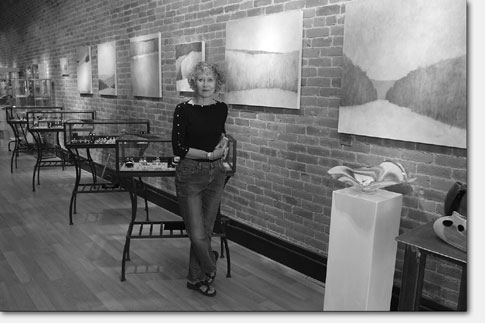| ||
The lay of the land
by Jules Masterjohn The prevalence of landscape imagery in art is a curiosity to many. Popular in America and especially in this region, some who are perplexed by the use of this time-honored subject can easily dismiss it as another example of the traditionalist values so common these days. There are compelling reasons, however, for artists to work from the landscape. Landscape imagery was first introduced into painting around 500 years ago, during the Renaissance period. Pastoral scenes and vast vistas were pictured as backgrounds receding into the distances, as in Leonardo da Vinci’s portrait of the Mona Lisa. Here, a range of geologic features, a winding road, jagged mountains, and large body of water, comprise the romantic countryside stretching out as far as the eye can see, behind the artist’s subject. The realistic portrayal of with its deep-space perspective was perfected during a time when scientific discoveries were expanding people’s understanding of their place in the universe. One revelation was Copernicus’ finding that the Earth revolved around the Sun, not the reverse, as was previously believed. Scientific observation made a lasting impact on how artists conceptualized the landscape and their place in it. Notions about the landscape may also be hard wired into us, lodged deeply in our primordial memory. Geographer Jay Appleton, in his 1975 book, The Experience of Landscape, suggests that our modern enjoyment for landscape is based on the kinds of environments that helped our species flourish and evolve. In his “habitat theory” he states, “that aesthetic pleasure in landscape derives from the observer experiencing an environment favorable to the satisfaction of his biological needs.” This must explain why so many people who view the landscape paintings by Cynthia DeBolt, currently on display at Ellis Crane Gallery, find them so pleasing. Perhaps DeBolt’s canvases, through their combined references to open space, fields and bodies of water as well as trees and foliage, touch a place inside our primitive psyche that feels safe and successful. She chuckles when people tell her how restful they find her oil paintings. For the artist, there is nothing relaxing about making them: she is solving problems with shape and color, value and line that engage her mind in a most demanding effort. “For me, each painting is a puzzle in which to work something out. With each one, I don’t know how it’s going to go when I start. I guess I’m comfortable tolerating ambiguity.” Her creative process begins with photographs that she has taken of landscapes that appeal to her. There might be some tiny part of a landscape that she wants to use in a painting, so the photographs are mounted on her easel during the initial stage of development. At many times thorughout the painting process, the canvas and photos are turned upside down and sideways, allowing for a distanced or objective view of the composition on the canvas. While this method helps DeBolt to create more abstract depictions of the landscape, it also is a solid technique for creating well-balanced and dynamic compositions. “These are not real places that I am painting, they are imagined. I am using the landscape as an arrangement of specific shapes and colors. Sometimes there is no reference to the photograph left in the finished painting.” Her penchant for abstracting the landscape is understandable when one considers the mixture of influences in her background. Though raised in a small rural town in Michigan, her parents valued the arts and culture and offered her “an urban mentality.” The broad expanses of land and groves of trees that surrounded her childhood home were balanced by frequent trips to the Cleveland Museum of Art. DeBolt spent her first 18 years absorbing the landscape, then left to attend art school at the University of Michigan in Ann Arbor. It was the mid-1960s when she was introduced to Abstract Expressionism through a painting professor who ad been part of the “AB EX generation” in New York and had rubbed shoulders with the likes of Jackson Pollock and William DeKooning. “He was a great teacher. Though my interests in painting were very different from his, he helped me recognized what was important to me, and I respected that in him.” Though her painting style bears little resemblance to the energetic “action painting” of Pollock, it does reveal a contemplative aspect more akin to the “color field painting” of Mark Rothko, one of her favorite artists. What DeBolt does share with the Abstract Expressionists is a philosophical perspective about the role of art in restoring our world by liberating us from worn-out concerns and helping us to refocus our priorities. DeBolt reflects, “It seems that with everything we all do, we just keep getting busier. Our heads are jammed full of something every minute. With my paintings I set out, on a philosophical level, to give some visual hint to the viewer, and to myself, about how to simplify our lives and get down to the essentials.” From this truth-seeking attitude, DeBolt chooses the canvas as her “place” in which to practice simplicity, and through landscape features, where open fields meet the forest’s edge, invites us, the viewer, to consider where we “locate” ourselves in this busy world. • Cynthia DeBolt’s paintings are on display at Ellis Crane Gallery, 934 Main Ave., in Durango.
|


